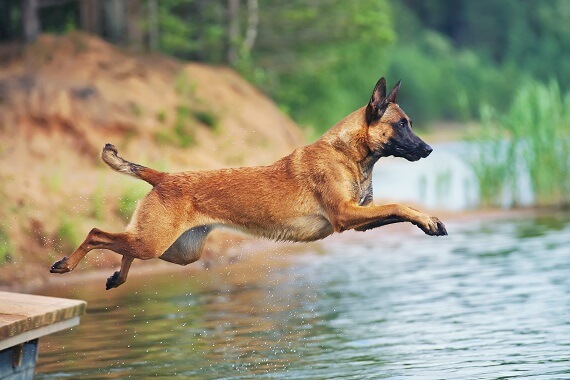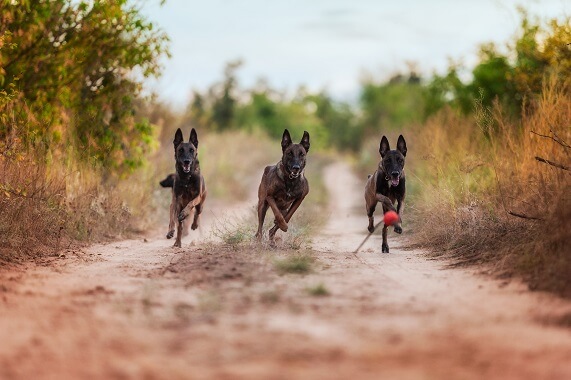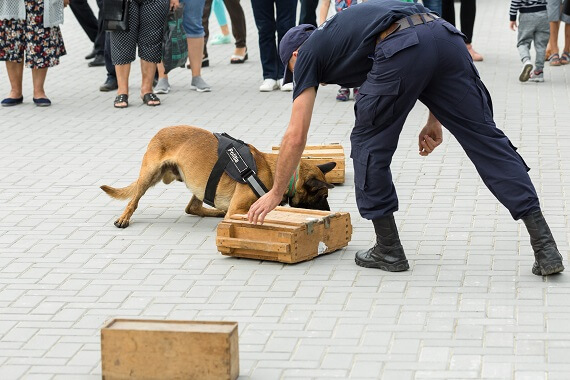
The Malinois, or Belgian Malinois, is one of four Belgian sheepdogs that originated in the North of Belgium in the 1800s. This dog is known for its smart, confident, and versatile disposition. These medium-sized dogs were primarily bred to work on farms, herding sheep and cattle. Malinois get there name from the town that first bred them – Maline, Belgium. They are often confused with German Shephards, but Malinois are more squarely built. They also have a more refined head. These dogs are well-muscled and very intelligent. They have a proud elegance about them and carry their heads held high. In more recent times, they have become the preferred dog for military service and law enforcement. They were used to carry messages during World War II, as well as working as border patrol and within groups such as the Red Cross. More recently, some even served as bomb-sniffers in Iraq and Afghanistan. The Malinois has a short, double-layered coat that is weather resistant. The coat color ranges from rich fawn to red to mahogany to black, with black shading on the hairs tips. Its underbelly, back end, and tail are often a lighter, tan color and the mask and ears are black. They have brown, almond-shaped eyes and erect, triangular ears. The males are larger than the females. Females also tend to be more slender and lighter than their male counterparts. These dogs make excellent pets but they do require a lot of exercise and mental stimulation. If they are left alone for long periods they can become bored and destructive. As a result of this, a lot of shelters end up with a large number of Malinois as people underestimate how much exercise and time they will need. These dogs can be trained well but they tend to dominate so require a firm owner. They do however form very strong bonds with their owners and can be very loyal and loving. Malinois are naturally alert and suspicious and make good guard dogs. However, they are mouthy and are quick to bite hard. They also tend to chew things. They require substantial training to channel their energy effectively. Malinois were originally bred as farm dogs, to be used in the herding of sheep and cattle. However, they have been used for a century by New York police and have even been used by the military due to several biological characteristics that make them particularly well suited for these roles. Let’s investigate further. Malinois are intelligent, agile, loyal, and stealthy making them the favored breed for working with the Navy SEALS in the US. They are fierce and fast, with acute vision and a strong sense of smell which makes them useful for detecting explosives. They are light, lean, and have a compact frame. These characteristics make them suitable for parachuting and repelling – activities which are common during Navy SEAL deployments -and has made them much more favorable than the German Shephard which has been traditionally used in police work. Belgian Malinois are considered good skydivers and can even be taught to skydive on their own! To become a Navy SEAL K9, these dogs undergo rigorous training from birth. They must be desensitized to loud sounds, learn social skills, and also learn to swim. In time they will undergo further training to detect explosives, to take part in search and rescue, and to track and apprehend persons of interest. Malinois are so good at this work that several of them are known to protect the grounds of the White House. One key characteristic that makes Malinois excellent military dogs is their strong sense of smell. Dogs, in general, have a strong sense of smell but not all are created equally and how good their sense of smell is can depend largely on the number of scent receptors found in their noses. Malinois have approximately 225 million scent receptors in their noses. To put this into context, dachshunds and bloodhounds are also known for having a strong sense of smell and they have 125 million and 300 million scent receptors, respectively. If we compare this to humans, that have around 5 million scent receptors, we can begin to understand just how strong a sense of smell this dog breed has. No wonder Malinois makes excellent tracking dogs! Another notable aspect of a dog’s sense of smell is that their nostrils work independently. A dog’s nose is structured differently from ours and their nostrils have different openings for breathing in and out. This means that a dog can sense a variety of smells coming from all different directions. A dog can use its sense of smell to detect fear or sadness and can be trained as service dogs to support people who suffer from certain difficulties. These dogs can also be trained to detect diseases and some dogs have been trained to detect cancer. Malinois shed lightly all year and have two heavy shedding periods annually, in the fall and spring. One of the reasons that Malinois shed so much is due to their double-layered coat. These dogs shed twice a year to grow different coats based on the seasons – a light summer coat and a thick winter undercoat. This natural warming and cooling mechanism is an important way that dogs adapt to their various environments. Shedding is a healthy and natural process that keeps a dog’s coat healthy. However, one way to keep up with a dog shedding its coat is to ensure that it is regularly groomed, especially during shedding periods.
Kingdom
Animalia
Phylum
Chordata
Class
Mammalia
Order
Carnivora
Family
Canidae
Genus
Canis
Species
Canis lupus
Subspecies
Canis lupus familiaris
Height
22 – 26 in ( 56 – 66 cm) at the shoulder
Weight
40 – 80 lb ( 18 – 36 kg)
Lifespan
14 – 16 years
Social Structure
Domesticated
Status
Least concern
Natural Habitat
Domesticated, prefer herding activities
Average Litter Size
6 – 10
Main food item
Dog food
Potential predators
Few predators
The Basics

Fun Facts about the Malinois
Malinois Work With Navy SEALS

Strong Sense of Smell

Big Shedders
